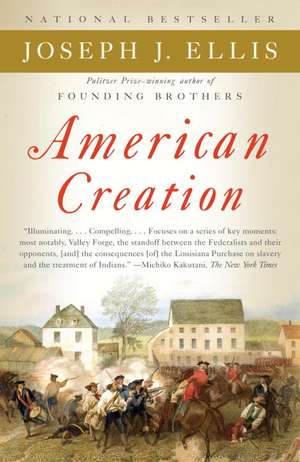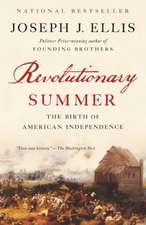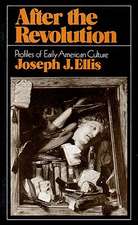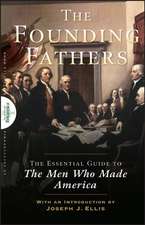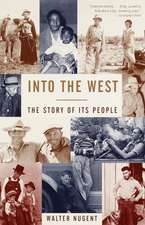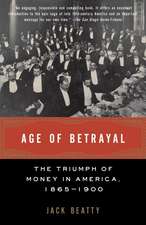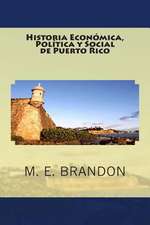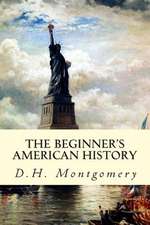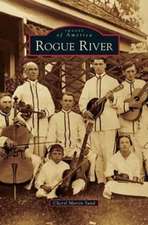American Creation: Triumphs and Tragedies in the Founding of the Republic
Autor Joseph J. Ellisen Limba Engleză Paperback – 30 sep 2008
Acclaimed historian Joseph J. Ellis brings his unparalleled talents to this riveting account of the early years of the Republic.
The last quarter of the eighteenth century remains the most politically creative era in American history, when a dedicated group of men undertook a bold experiment in political ideals. It was a time of both triumphs and tragedies—all of which contributed to the shaping of our burgeoning nation. Ellis casts an incisive eye on the gradual pace of the American Revolution and the contributions of such luminaries as Washington, Jefferson, and Madison, and brilliantly analyzes the failures of the founders to adequately solve the problems of slavery and the treatment of Native Americans. With accessible prose and stunning eloquence, Ellis delineates in American Creation an era of flawed greatness, at a time when understanding our origins is more important than ever.
Preț: 87.78 lei
Nou
Puncte Express: 132
Preț estimativ în valută:
16.80€ • 18.26$ • 14.12£
16.80€ • 18.26$ • 14.12£
Carte disponibilă
Livrare economică 31 martie-14 aprilie
Livrare express 15-21 martie pentru 22.13 lei
Preluare comenzi: 021 569.72.76
Specificații
ISBN-13: 9780307276452
ISBN-10: 0307276457
Pagini: 283
Dimensiuni: 134 x 202 x 23 mm
Greutate: 0.3 kg
Editura: Vintage Books USA
ISBN-10: 0307276457
Pagini: 283
Dimensiuni: 134 x 202 x 23 mm
Greutate: 0.3 kg
Editura: Vintage Books USA
Notă biografică
Joseph Ellis is the Pulitzer Prize-winning author of Founding Brothers. His portrait of Thomas Jefferson, American Sphinx, won the National Book Award. He is the Ford Foundation Professor of History at Mount Holyoke College. He lives in Amherst, Massachusetts, with his wife, Ellen, and their youngest son, Alex.
Extras
Chapter One: The Year
If permitted the historical license to stretch the definition of a year, then the fifteen months between the shots fired at Lexington and Concord in April of 1775 and the adoption of the Declaration of Independence in July of 1776 can justifiably claim to be both the most consequential and the strangest year in American history. It was consequential because the rationale for American independence and the political agenda for an independent American republic first became explicit at this time. It was strange because while men were dying, whole towns being burned to the ground, women being raped, captured spies and traitors being executed, the official posture of what called itself “The United Colonies of North America” remained abiding loyalty to the British Crown.[1]
Whether the American colonists were living a lie, an illusion, or a calculated procrastination is a good question. But when Thomas Jefferson finally got around to drafting the Declaration of Independence in June of 1776, one sentence enjoyed special resonance as an accurate characterization of the past year: “Prudence, indeed, will dictate that governments long established should not be changed for light and transient causes; and accordingly all experience hath shown, that mankind are more disposed to suffer, while evils are sufferable, than to right themselves by abolishing the forms to which they are accustomed.” This was Jefferson’s lyrical way of describing the quite remarkable feat of making an explosion happen in slow motion.
After all, prudence does not ordinarily make its way onto any list of revolutionary virtues. The very idea of a cautious revolutionary would seem, on the face of it, a contradiction in terms. The standard story of most revolutions features a cast of desperate characters with impulsive temperaments, utopian visions, a surefire sense of where history is headed, and an unquenchable urge to get there fast. Indeed, tarrying along the way is usually regarded as counterrevolutionary.
If that is what the standard story of a revolution requires, then one of two conclusions about the American Revolution follows naturally: either it was not really a revolution at all but merely (or perhaps not so merely) a war for colonial independence, the first of its kind in the modern world, to be sure, but not a fundamental shift in the social order that left the world changed forever. Or else it was a strange kind of revolution that did not fit the standard pattern because many of its most prominent leaders were convinced that the pace of change must be slowed down and the most radical of the revolutionary promises deferred. The result is another contradiction, or perhaps a paradox: namely, an evolutionary revolution.
In short, the decision to secede from the British Empire was accompanied by a truly revolutionary agenda for the infant American republic. But the most prominent leaders, John Adams chief among them, insisted on the deferral of the revolutionary agenda and, in some instances, its postponement into the distant future. Instead of regarding this gradualist approach as a moral and political failure, a conclusion that historians on the left regard as, shall we say, self-evident, the argument offered here is just the opposite. In my judgment the calculated decision to make the American Revolution happen in slow motion was a creative act of statesmanship that allowed the United States to avoid the bloody and chaotic fate of subsequent revolutionary movements in France, Russia, and China.
And so, within a very strange year of full-scale war occurring alongside political reticence, we find an equally strange pattern emerging that will establish the uniquely judicious framework within which the American Revolution proceeded. John Adams, the major figure in the Continental Congress, and George Washington, the commander in chief of the Continental Army, are the chief players in this unusual story. Thomas Paine, who fits the more conventional revolutionary pattern perfectly, turns out to be the exception rather than the rule, temporarily indispensable but ultimately disposable. The great creative achievement embodied in the leadership of Adams and Washington at this propitious moment was to assure that the American Revolution moved forward, to borrow a modern phrase, with all deliberate speed.
HINDSIGHTS
When John Adams looked back from retirement on his experience thirty years earlier in the Second Continental Congress, two recollections nudged out all the other memories. The first was a bit awkward to acknowledge publicly, but since Adams believed that truth should always trump modesty (especially false modesty), he laid down his personal marker on the proceedings: “I was incessantly employed through the Whole Fall, Winter and Spring of 1775 and 1776 during their Sittings and on Committees on mornings and Evenings,” he recalled, “and unquestionably did more business than any other Member of that house.”[2]
The second recollection had the effect of making the first impossible to verify. No true history of that fateful time would ever be written, Adams insisted, because the most important conversations occurred “out of doors” in local taverns and coffeehouses. What’s more, the official record of the deliberations imposed a misleading gloss of coherence over the congressional proceedings, concealing the messy confusion that reigned supreme for all the delegates, himself included. Any coherent narrative of the deliberations must necessarily falsify the way it really was for all the participants, who were improvising without a script in a historical drama without a known conclusion.[3]
Adams was making a serious, perhaps even a profound, point: namely, that retrospective history—that is, history viewed with the benefit of hindsight—is invariably neater and tidier than history as experienced by those making it. But since hindsight is the only interpretive tool historians have at their disposal, we must run the risk of deploying it here, enjoying the clairvoyance that Adams and his fellow delegates were denied in order to establish the political context of the imperial crisis that they, albeit lacking our prescient perch, were confronting in the late spring and summer of 1775.
Why was there an imperial crisis? The answer of the moment was that British troops had gunned down ninety-five American patriots at Lexington and Concord. Adams was not sure whether this blood-letting would become the opening shot in a war for American independence. He was sure that it represented another escalation in what had become a twelve-year argument about the proper place of the American colonies within a reconfigured British Empire. The Adams version of that dispute was highly partisan. In effect, a corrupt British government had arbitrarily decided to impose new taxes and political restrictions on its loyal American subjects as part of a conspiratorial plot to deprive them of their traditional rights as Englishmen. The carnage at Lexington and Concord, then, was the logical and inevitable culmination of a conscious British scheme to transform loyal subjects into abject slaves.[4]
Hindsight permits a more detached and ultimately ironic version of the imperial story. In 1763, as a result of its stupendous victory in the French and Indian War, Great Britain found itself a newly arrived world power with a vast empire in the eastern third of North America. Previously, British governance of their thirteen coastal colonies had been a lackadaisical affair, with royal governors largely beholden to local legislatures, which controlled the power of the purse. Enforcement of the trade regulations purportedly required by the Navigation Acts was equally blithe in spirit. Now, however, the sheer scale of its recently acquired American empire, plus the sudden recognition that governance of its expanded domain required more management than a few secretaries and clerks in Whitehall could muster, forced a major overhaul of this accidental empire into something more appropriately imperial. What looked to Adams like a sinister plot to enslave the American colonists was viewed from London as a sensible plan to make the British Empire worthy of its name.[5]
There then ensued a decade of parliamentary legislation—the Sugar Act, the Stamp Act, the Townshend Acts, the Coercive Acts—all designed to fold the colonies into the empire by placing them within the authority of Parliament, which represented the collective interests of all British citizens everywhere. The colonists, of course, contested that claim, Adams leading the way by arguing that American interests were not represented in Parliament, but rather in the respective colonial legislatures, which alone could justifiably speak for American interests because they alone were duly elected to do so.[6]
Knowing as we do the world-changing events about to transpire—a seven-and-a-half-year war in which more Americans were killed or wounded proportionally than in any subsequent conflict save the Civil War, in which the British lost their entire empire in North America except for Canada—it seems strange that such a massive movement of the historical templates could be caused by such a minor, merely constitutional, difference of opinion. In retrospect, the core problem blocking a sensible resolution was the British presumption—fully as self-evident to them as the truths that Jefferson was soon to hurl at “a candid world”—that imperial sovereignty must be singular. For George III and his chief minister, Lord North, it was akin to an axiom of political physics, a veritable Newtonian principle of political theory, that there must be one sovereign source of governance. To suggest otherwise was tantamount to arguing there was not one but many gods.
If they could only have jettisoned that assumption, a workable solution to the imperial crisis was staring them right in the face. Indeed it was proposed by the First Continental Congress in 1774 and would be proposed several times again by the Second Continental Congress throughout 1775 and up to July of 1776. The solution was shared sovereignty, whereby the American colonies remained within the British Empire as loyal subjects of the Crown but retained control over their own domestic affairs. A version of this creative solution, called federalism, became the basis for the American constitutional settlement in 1787–88. A century later the same principle became the organizing feature of the British Commonwealth. Our dalliance with hindsight, then, ends with two overlapping conclusions: first, the American Revolution was eminently avoidable; second, the imaginative failure of the British ministry in 1775–76 constitutes perhaps the greatest blunder in the history of British statecraft.[7]
NOTES
[1] Three previous studies of this awkward year that strike me as first rate are Allen French, The First Year of the American Revolution (Boston, 1934); Thomas Fleming, 1776: Year of Illusions (New York, 1975); and, more recently, David McCullough, 1776 (New York, 2005).
[2] AD 3:355.
[3] The quotation is from Adams to Benjamin Rush, 17 August 1812, in John A. Schutz and Douglass Adair, eds., The Spur of Fame: Dialogues of John Adams and Benjamin Rush, 1805-1813 (San Marino, Calif.: 1966). I have assessed the Adams posture toward all straight-line narratives of the American Revolution in Founding Brothers: The Revolutionary Generation (New York: 2001), 215-81. On Adams's role in the Continental Congress, the semifictional account by Catherine Drinker Bowen, John Adams and the American Revolution (Boston, 1950), still manages to capture the context most imaginatively.
[4] Adams is almost a textbook example of the revolutionary mentality first identified by Bernard Bailyn in Ideological Origins of the American Revolution (Cambridge, Mass., 1967).
[5] The first historian to insist on viewing the American Revolution from the British perspective was Lawrence H. Gipson, who summarized his multivolume account in The Coming of the Revolution, 1763-1775 (New York, 1954). The most recent version of this imperial interpretation is Theodore Draper, A Struggle for Power: The American Revolution (New York, 1996).
[6] On the role of the colonial assemblies, the authoritative work is Jack P. Greene, The Quest for Power: The Lower Houses of Assembly in Southern Royal Colonies, 1689-1776 (Chapel Hill, 1963).
[7] My conclusion here is harsh, but I find it inescapable. See, for example, Robert W. Tucker and David C. Hendrickson, The Fall of the First British Empire (Baltimore, 1982). On the British side of the story, equally derogatory, see Stanley Weintraub, Iron Tears: America's Battle for Freedom, Britain's Quagmire, 1775-83 (New York, 2005).
From the Hardcover edition.
If permitted the historical license to stretch the definition of a year, then the fifteen months between the shots fired at Lexington and Concord in April of 1775 and the adoption of the Declaration of Independence in July of 1776 can justifiably claim to be both the most consequential and the strangest year in American history. It was consequential because the rationale for American independence and the political agenda for an independent American republic first became explicit at this time. It was strange because while men were dying, whole towns being burned to the ground, women being raped, captured spies and traitors being executed, the official posture of what called itself “The United Colonies of North America” remained abiding loyalty to the British Crown.[1]
Whether the American colonists were living a lie, an illusion, or a calculated procrastination is a good question. But when Thomas Jefferson finally got around to drafting the Declaration of Independence in June of 1776, one sentence enjoyed special resonance as an accurate characterization of the past year: “Prudence, indeed, will dictate that governments long established should not be changed for light and transient causes; and accordingly all experience hath shown, that mankind are more disposed to suffer, while evils are sufferable, than to right themselves by abolishing the forms to which they are accustomed.” This was Jefferson’s lyrical way of describing the quite remarkable feat of making an explosion happen in slow motion.
After all, prudence does not ordinarily make its way onto any list of revolutionary virtues. The very idea of a cautious revolutionary would seem, on the face of it, a contradiction in terms. The standard story of most revolutions features a cast of desperate characters with impulsive temperaments, utopian visions, a surefire sense of where history is headed, and an unquenchable urge to get there fast. Indeed, tarrying along the way is usually regarded as counterrevolutionary.
If that is what the standard story of a revolution requires, then one of two conclusions about the American Revolution follows naturally: either it was not really a revolution at all but merely (or perhaps not so merely) a war for colonial independence, the first of its kind in the modern world, to be sure, but not a fundamental shift in the social order that left the world changed forever. Or else it was a strange kind of revolution that did not fit the standard pattern because many of its most prominent leaders were convinced that the pace of change must be slowed down and the most radical of the revolutionary promises deferred. The result is another contradiction, or perhaps a paradox: namely, an evolutionary revolution.
In short, the decision to secede from the British Empire was accompanied by a truly revolutionary agenda for the infant American republic. But the most prominent leaders, John Adams chief among them, insisted on the deferral of the revolutionary agenda and, in some instances, its postponement into the distant future. Instead of regarding this gradualist approach as a moral and political failure, a conclusion that historians on the left regard as, shall we say, self-evident, the argument offered here is just the opposite. In my judgment the calculated decision to make the American Revolution happen in slow motion was a creative act of statesmanship that allowed the United States to avoid the bloody and chaotic fate of subsequent revolutionary movements in France, Russia, and China.
And so, within a very strange year of full-scale war occurring alongside political reticence, we find an equally strange pattern emerging that will establish the uniquely judicious framework within which the American Revolution proceeded. John Adams, the major figure in the Continental Congress, and George Washington, the commander in chief of the Continental Army, are the chief players in this unusual story. Thomas Paine, who fits the more conventional revolutionary pattern perfectly, turns out to be the exception rather than the rule, temporarily indispensable but ultimately disposable. The great creative achievement embodied in the leadership of Adams and Washington at this propitious moment was to assure that the American Revolution moved forward, to borrow a modern phrase, with all deliberate speed.
HINDSIGHTS
When John Adams looked back from retirement on his experience thirty years earlier in the Second Continental Congress, two recollections nudged out all the other memories. The first was a bit awkward to acknowledge publicly, but since Adams believed that truth should always trump modesty (especially false modesty), he laid down his personal marker on the proceedings: “I was incessantly employed through the Whole Fall, Winter and Spring of 1775 and 1776 during their Sittings and on Committees on mornings and Evenings,” he recalled, “and unquestionably did more business than any other Member of that house.”[2]
The second recollection had the effect of making the first impossible to verify. No true history of that fateful time would ever be written, Adams insisted, because the most important conversations occurred “out of doors” in local taverns and coffeehouses. What’s more, the official record of the deliberations imposed a misleading gloss of coherence over the congressional proceedings, concealing the messy confusion that reigned supreme for all the delegates, himself included. Any coherent narrative of the deliberations must necessarily falsify the way it really was for all the participants, who were improvising without a script in a historical drama without a known conclusion.[3]
Adams was making a serious, perhaps even a profound, point: namely, that retrospective history—that is, history viewed with the benefit of hindsight—is invariably neater and tidier than history as experienced by those making it. But since hindsight is the only interpretive tool historians have at their disposal, we must run the risk of deploying it here, enjoying the clairvoyance that Adams and his fellow delegates were denied in order to establish the political context of the imperial crisis that they, albeit lacking our prescient perch, were confronting in the late spring and summer of 1775.
Why was there an imperial crisis? The answer of the moment was that British troops had gunned down ninety-five American patriots at Lexington and Concord. Adams was not sure whether this blood-letting would become the opening shot in a war for American independence. He was sure that it represented another escalation in what had become a twelve-year argument about the proper place of the American colonies within a reconfigured British Empire. The Adams version of that dispute was highly partisan. In effect, a corrupt British government had arbitrarily decided to impose new taxes and political restrictions on its loyal American subjects as part of a conspiratorial plot to deprive them of their traditional rights as Englishmen. The carnage at Lexington and Concord, then, was the logical and inevitable culmination of a conscious British scheme to transform loyal subjects into abject slaves.[4]
Hindsight permits a more detached and ultimately ironic version of the imperial story. In 1763, as a result of its stupendous victory in the French and Indian War, Great Britain found itself a newly arrived world power with a vast empire in the eastern third of North America. Previously, British governance of their thirteen coastal colonies had been a lackadaisical affair, with royal governors largely beholden to local legislatures, which controlled the power of the purse. Enforcement of the trade regulations purportedly required by the Navigation Acts was equally blithe in spirit. Now, however, the sheer scale of its recently acquired American empire, plus the sudden recognition that governance of its expanded domain required more management than a few secretaries and clerks in Whitehall could muster, forced a major overhaul of this accidental empire into something more appropriately imperial. What looked to Adams like a sinister plot to enslave the American colonists was viewed from London as a sensible plan to make the British Empire worthy of its name.[5]
There then ensued a decade of parliamentary legislation—the Sugar Act, the Stamp Act, the Townshend Acts, the Coercive Acts—all designed to fold the colonies into the empire by placing them within the authority of Parliament, which represented the collective interests of all British citizens everywhere. The colonists, of course, contested that claim, Adams leading the way by arguing that American interests were not represented in Parliament, but rather in the respective colonial legislatures, which alone could justifiably speak for American interests because they alone were duly elected to do so.[6]
Knowing as we do the world-changing events about to transpire—a seven-and-a-half-year war in which more Americans were killed or wounded proportionally than in any subsequent conflict save the Civil War, in which the British lost their entire empire in North America except for Canada—it seems strange that such a massive movement of the historical templates could be caused by such a minor, merely constitutional, difference of opinion. In retrospect, the core problem blocking a sensible resolution was the British presumption—fully as self-evident to them as the truths that Jefferson was soon to hurl at “a candid world”—that imperial sovereignty must be singular. For George III and his chief minister, Lord North, it was akin to an axiom of political physics, a veritable Newtonian principle of political theory, that there must be one sovereign source of governance. To suggest otherwise was tantamount to arguing there was not one but many gods.
If they could only have jettisoned that assumption, a workable solution to the imperial crisis was staring them right in the face. Indeed it was proposed by the First Continental Congress in 1774 and would be proposed several times again by the Second Continental Congress throughout 1775 and up to July of 1776. The solution was shared sovereignty, whereby the American colonies remained within the British Empire as loyal subjects of the Crown but retained control over their own domestic affairs. A version of this creative solution, called federalism, became the basis for the American constitutional settlement in 1787–88. A century later the same principle became the organizing feature of the British Commonwealth. Our dalliance with hindsight, then, ends with two overlapping conclusions: first, the American Revolution was eminently avoidable; second, the imaginative failure of the British ministry in 1775–76 constitutes perhaps the greatest blunder in the history of British statecraft.[7]
NOTES
[1] Three previous studies of this awkward year that strike me as first rate are Allen French, The First Year of the American Revolution (Boston, 1934); Thomas Fleming, 1776: Year of Illusions (New York, 1975); and, more recently, David McCullough, 1776 (New York, 2005).
[2] AD 3:355.
[3] The quotation is from Adams to Benjamin Rush, 17 August 1812, in John A. Schutz and Douglass Adair, eds., The Spur of Fame: Dialogues of John Adams and Benjamin Rush, 1805-1813 (San Marino, Calif.: 1966). I have assessed the Adams posture toward all straight-line narratives of the American Revolution in Founding Brothers: The Revolutionary Generation (New York: 2001), 215-81. On Adams's role in the Continental Congress, the semifictional account by Catherine Drinker Bowen, John Adams and the American Revolution (Boston, 1950), still manages to capture the context most imaginatively.
[4] Adams is almost a textbook example of the revolutionary mentality first identified by Bernard Bailyn in Ideological Origins of the American Revolution (Cambridge, Mass., 1967).
[5] The first historian to insist on viewing the American Revolution from the British perspective was Lawrence H. Gipson, who summarized his multivolume account in The Coming of the Revolution, 1763-1775 (New York, 1954). The most recent version of this imperial interpretation is Theodore Draper, A Struggle for Power: The American Revolution (New York, 1996).
[6] On the role of the colonial assemblies, the authoritative work is Jack P. Greene, The Quest for Power: The Lower Houses of Assembly in Southern Royal Colonies, 1689-1776 (Chapel Hill, 1963).
[7] My conclusion here is harsh, but I find it inescapable. See, for example, Robert W. Tucker and David C. Hendrickson, The Fall of the First British Empire (Baltimore, 1982). On the British side of the story, equally derogatory, see Stanley Weintraub, Iron Tears: America's Battle for Freedom, Britain's Quagmire, 1775-83 (New York, 2005).
From the Hardcover edition.
Recenzii
“Illuminating. . . . Compelling. . . . Focuses on a series of key moments: most notably, Valley Forge, the standoff between the Federalists and their opponents, [and] the consequences [of] the Louisiana Purchase on slavery and the treatment of Indians.” —Michiko Kakutani, The New York Times
“[Ellis] is a storyteller, and a superb one ... no historian is better at making a complicated jumble of events clear and comprehensible.” —The New York Review of Books
“Illuminating ... entertaining.... Ellis has done us a great service.” —The New York Times Book Review
“Delightful.... Ellis is the reigning master of the episodic approach to history.” —The Boston Globe
“[Ellis] is a storyteller, and a superb one ... no historian is better at making a complicated jumble of events clear and comprehensible.” —The New York Review of Books
“Illuminating ... entertaining.... Ellis has done us a great service.” —The New York Times Book Review
“Delightful.... Ellis is the reigning master of the episodic approach to history.” —The Boston Globe
Descriere
From the first shots fired at Lexington to the negotiations for the Louisiana Purchase, Ellis guides readers through the decisive issues of the nation's founding. The author strips the mythic veneer of America's iconic founders to reveal men possessed of both brilliance and blindness.
